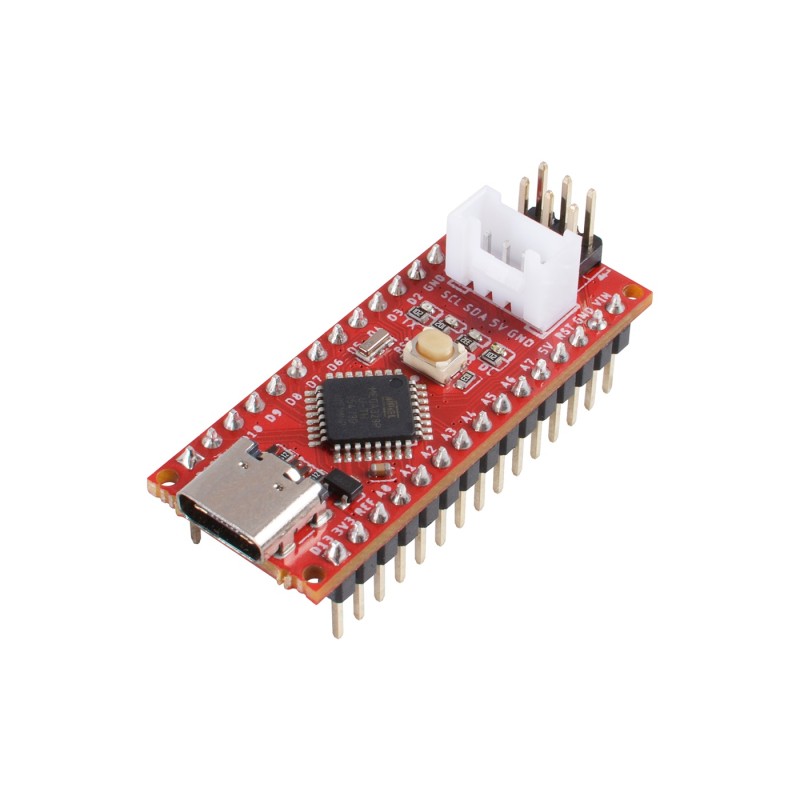





Seeeduino Nano is a compact board similar to Seeeduino V4.2/Arduino UNO and fully compatible with Arduino Nano in terms of pinout and size. It uses an ATmega328P microcontroller equipped with 32 kB of Flash memory and 2 kB of RAM. It offers 14 digital IO pins, as well as 6 PWM outputs, 8 analog inputs and SPI, I2C and UART communication interfaces.

Compared to Arduino Nano, Seeeduino Nano uses a USB Type-C connector (which is symmetrical and reversible) instead of Mini-USB. It also introduces improvements in the form of a Grove I2C connector and allows you to use the Grove system to play with hundreds of sensors and actuators by connecting them in a simple way. Full documentation is available on the product page.
Data sheet
Manufacturer BTC Korporacja sp. z o. o. Lwowska 5 05-120 Legionowo Poland sprzedaz@kamami.pl 22 767 36 20
Responsible person BTC Korporacja sp. z o. o. Lwowska 5 05-120 Legionowo Poland sprzedaz@kamami.pl 22 767 36 20
Cable with USB typ A and USB typ C connectors, cable length 0.5 m. LANBERG
Cable with USB typ A and USB typ C connectors, cable length 1 m. LANBERG CA-USBO-10CC-0010-BK
Cable with USB typ A and USB typ C connectors, cable length 1,8 m. LANBERG CA-USBO-10CC-0018-BK
Microcontroller board based on the ATmega328
Board with ATmega2560 microcontroller (256 kB Flash, 8 kB RAM, 4 kB EEPROM) clocked at 16 MHz. USB-UART converter based on the ATmega16u2 chip. The user has at his disposal, among others: 54 I/O lines, 14 PWM channels, 16 analog inputs.
No product available!
Virtual keyboard module in the form of a small flash drive. It allows you to simulate the keyboard after uploading the appropriate software and pressing a combination of buttons on the computer.
No product available!
Module with ATmega4808 microcontroller from AVR family (48 KB Flash, 6 KB SRAM, 256 B EEPROM). The module has 14 I / O lines, 6 PWM channels, 8 analog inputs.
No product available!
Development board with NXP iMX RT1011 processor with ARM Cortex M7 core equipped with AirLift WiFi module. It has Arduino UNO compatible connectors and a STEMMA QT connector for I2C devices. Adafruit 4950
No product available!
Development board with ATmega328P microcontroller compatible with Arduino Uno Rev3. Waveshare R3 PLUS
Development board based on the R7FA4M1AB3CFM microcontroller and compatible with Arduino UNO R4 Minima. Waveshare R7FA4 PLUS A
Board with Atmel ATmega328 microcontroller from the AVR family, there are 14 I / O lines, 6 PWM channels and 6 analog inputs. The additional ATmega16U4 microcontroller realizes communication via the USB interface
Microcontroller board based on the ATmega32u4
Board compatible with Arduino, based on ATmega328P. Equipped with an area with prototype holes, a breadboard, 12 LEDs, a button and a buzzer. Cytron MAKER-UNO-X
Development board with SAMD21G18 microcontroller. It offers operating frequency up to 48 MHz, 256kB FLASH memory and 32kB SRAM.
No product available!
Equipped with an equivalent Atmel ATmega328 microcontroller from the AVR family, the board offers 14 I/O lines, 6 PWM channels, and 6 analog inputs. An additional chip communicates via the USB interface
Development board based on the R7FA4M1AB3CFM microcontroller and compatible with Arduino UNO R4 WiFi. It is equipped with ESP32-S3FN8 with a dual-core 32-bit Xtensa LX7 core and wireless communication in the 2.4GHz WiFi band and Bluetooth LE. Waveshare R7FA4 PLUS B
Board with Atmel ATmega328P microcontroller from the AVR family, there are 14 I / O lines, 6 PWM channels and 6 analog inputs. The additional ATmega16U4 microcontroller realizes communication via the USB interface
Microcontroller board based on Leaf Maple, STM32F103RB, USB, RoHS
DFRobot DFR0355 is a versatile development board that combines GSM, GPRS, and GPS functions into one compact device. With the ATmega32u4 microcontroller and integrated SIM808 module, this board is ideal for applications such as vehicle tracking, remote communication, satellite positioning, and IoT projects. Built-in power-saving features and battery power make it an excellent choice for applications requiring low power consumption and reliable operation in various conditions. DFRobot DFR0355

A compact board similar to Seeeduino V4.2/Arduino UNO and fully compatible with Arduino Nano. It uses a USB Type C connector and a Grove I2C connector. Seeed Studio 102010268
